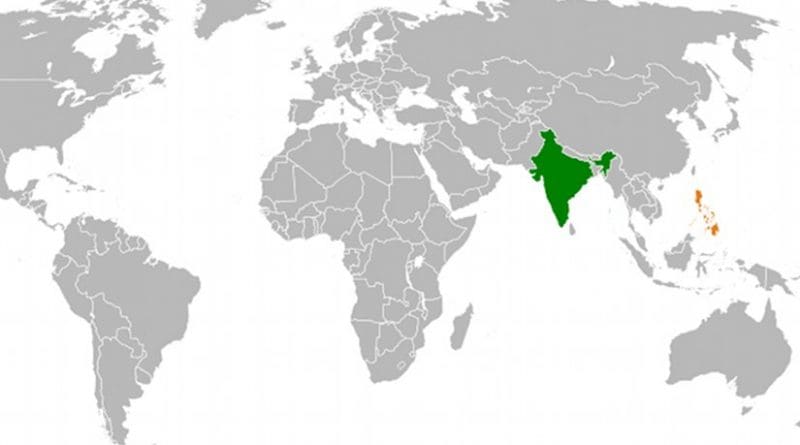India’s Look East Policy: Implications For The Philippines – Analysis
India’s Look East policy (LEP) of cultivating good relations with Southeast Asia presents opportunities as well as challenges for the Philippines. In Manila’s attempt to diversify its security partners and move away from over reliance on US support for external defence, India appears to be a good complement. However, in the context of increasing Sino-Indian regional rivalry, would Manila’s India gambit only complicate its already strained relations with China? Also, in its on-going standoff with China over Panatag Shoal and the West Philippine Sea, what immediate impact would closer Philippine-India relations bring to the table in Manila’s favour?
India and the Philippines established diplomatic relations in 1949, but defence cooperation between the two is a relatively recent development. In 2006, President Abdul Kalam paid a state visit to the Philippines wherein the two countries signed four bilateral agreements, including one on defence cooperation. The agreement called for greater interaction between the military personnel of the two countries, information exchange and training of Philippine military personnel in India. This cooperation is sustained by secretary-level meetings and Philippine participation in Indian defence expositions. In recent years, with the Philippines facing increasing external security pressure, the intensity of this cooperation has been elevated with Indian navy ships visiting the Philippines in 2010 and 2011, and an Indian defence delegation visiting Manila in May 2011. The budding partnership eventually culminated in the first ever Joint Defence Cooperation Committee meeting between the two countries held in Manila in January, 2012.
However, despite this increasing positive interaction, there is still much room for improvement in the bilateral ties of the two countries. Only one slot was allotted for Philippine military personnel training in India. Furthermore, despite the advances made by India’s home-grown defence sector, the Philippines had yet to procure cheaper Indian military hardware at friendly terms. Other areas for possible bilateral cooperation also remain understudied. In fact, when compared to other ASEAN countries, the Philippines is already being left out in the race to constructively engage India in Southeast Asia. Malaysia has already benefited from Indian assistance in the development of its national navy. Vietnam is currently at the forefront of engaging India as a way to balance Chinese influence in the South China Sea (SCS). Indian state-owned energy company ONGC is participating in oil exploration in waters within Vietnam’s EEZ, which China contests. And in order to protect ONGC platforms, New Delhi had already dispatched naval ships in the area.
South China Sea is not China’s
India considers the South Cina Sea (SCS) as a second major maritime theatre. It connects the Indian and Pacific Oceans and is a major world trade and commercial artery. In the same vein as the US, Australia, and Japan, India is after freedom of navigation and would consider the scenario of the SCS being controlled by a major regional power as a serious threat to these navigational rights. The sea is also believed to be sitting in a vast amount of hydrocarbon wealth which can help address India’s domestic energy security. There are also some quarters in the Indian defence establishment who feels that New Delhi has to counter-perceive Chinese encirclement of India, with China nurturing close economic and military ties with Pakistan, Myanmar, Nepal and Bangladesh. Establishing a naval footprint in the SCS through friendly ASEAN countries will be one way of countering this Chinese move. Moreover, India will not allow itself to be simply boxed in within South Asia and in the Indian Ocean in the same way as China would not permit other countries to confine it in Southeast Asia alone. Growing maritime ambitions fuelled by a rising economy would encourage the Indian navy and merchant ships to reach farther shores for energy supplies, exporting finished goods and sourcing raw materials. Thus, India’s LEP has serious economic, political and strategic underpinnings.
Balance with care
India’s drive to the east, and the Philippines, will demand reliable security partners which will find a confluence where mutual national interests can both be served. Manila will keenly observe how far New Delhi can put up with China in defending its oil exploration agreement with Hanoi. After suffering Chinese harassments in a similar oil exploration in the Reed Bank, off western Palawan and well within the Philippines’ own EEZ, Manila will surely welcome Indian energy investments, especially if they are accompanied by naval backing and assistance in upgrading the naval and coast guard capabilities of the country.
For the Philippines, India can be a balance against China’s growing presence in the SCS. Indian oil companies can help the country harness and protect its energy and marine resources. But careful balancing must be pursued. China remains the third biggest export market, third largest source of imported goods and fourth largest tourist market for the Philippines. China is also among the top major investors and aid donors to the country. Until such time that India can offer what the Philippines may lose if it becomes too close to India, a safe distance must be maintained.
Lucio Blanco Pitlo III
Graduate student, Asian Center, University of the Philippines
email: [email protected]
This article was published by the Institute of Peace & Conflict Studies and reprinted with permission


India should further strengthen its Navy to protect Indian ocean area and South China sea from Chinese aggression. India should co-operate with all like minded countries in a mutual beneficial manner.
India needs a very strong Navy and airforce. India should go in for multiple nuclear submarine and sign up agreement from like minded countries for managing mutual securities against bully like China.
VA, USA
India needs to strengthen its cooperation directly(if possible)to all ASEAN member states. Economic ties, political sense, and defense cooperation. Through these, relationship will turn out from bully China (who has been showing threat to his underdog neighbors)to deserving nation with prospect of leading the world without hampering its neighbors that I’ve seen in India.